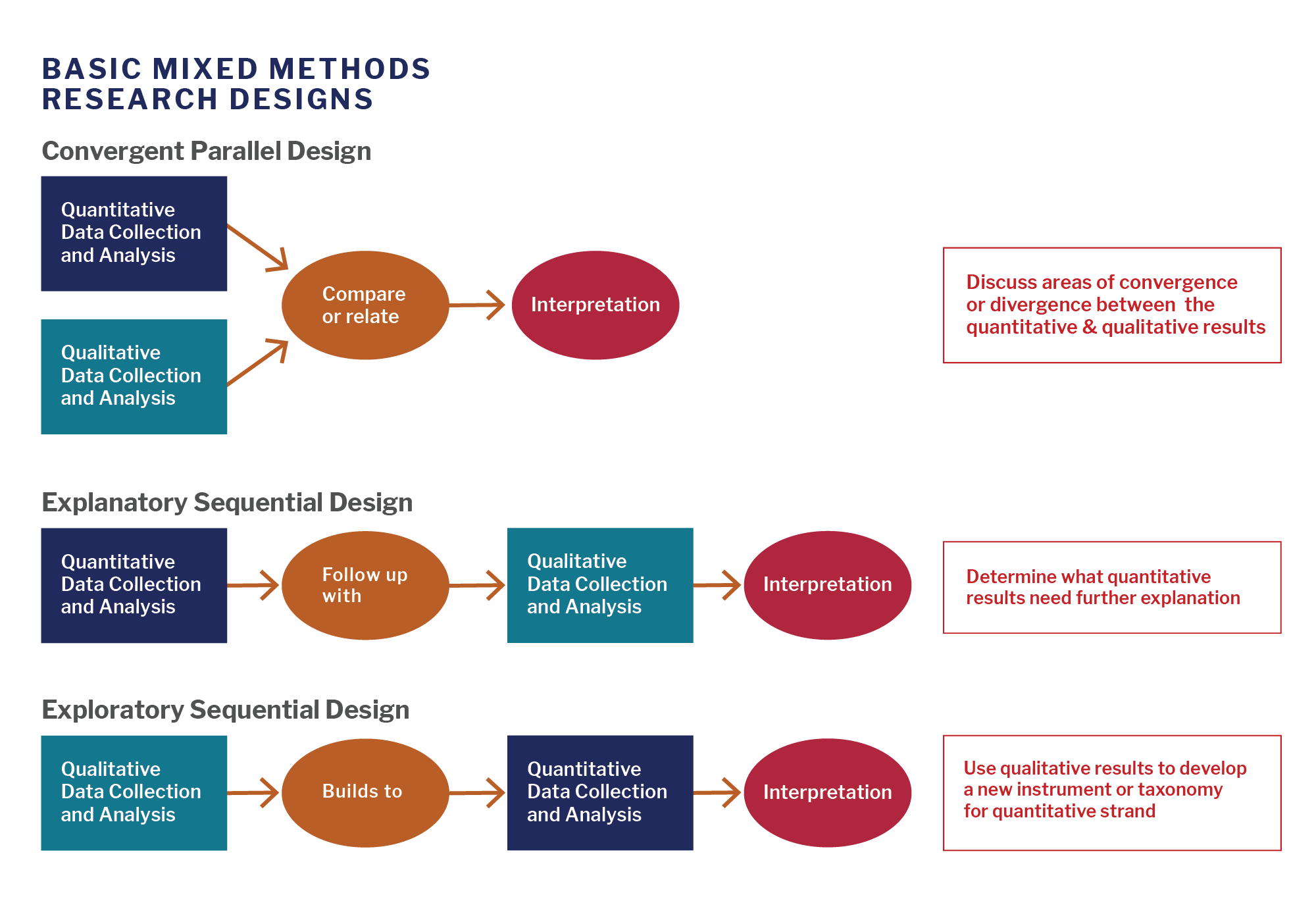For more information:
Email UsMixed Methods Research
According to the National Institutes of Health, mixed methods strategically integrates or combines rigorous quantitative and qualitative research methods to draw on the strengths of each. Mixed method approaches allow researchers to use a diversity of methods, combining inductive and deductive thinking, and offsetting limitations of exclusively quantitative and qualitative research through a complementary approach that maximizes strengths of each data type and facilitates a more comprehensive understanding of health issues and potential resolutions.¹ Mixed methods may be employed to produce a robust description and interpretation of the data, make quantitative results more understandable, or understand broader applicability of small-sample qualitative findings.
Integration
This refers to the ways in which qualitative and quantitative research activities are brought together to achieve greater insight. Mixed methods is not simply having quantitative and qualitative data available or analyzing and presenting data findings separately. The integration process can occur during data collection, analysis, or in the presentation of results.
Basic Mixed Methods Research Designs

View image description.
Figure adapted from Creswell, J. W. (2014). A concise introduction to mixed methods research. SAGE Publications.
Five Key Questions for Getting Started
- What do you want to know?
- What will be the detailed quantitative, qualitative, and mixed methods research questions that you hope to address?
- What quantitative and qualitative data will you collect and analyze?
- Which rigorous methods will you use to collect data and/or engage stakeholders?
- How will you integrate the data in a way that allows you to address the first question?
Rationale for Using Mixed Methods
- Obtain different, multiple perspectives: validation
- Build comprehensive understanding
- Explain statistical results in more depth
- Have better contextualized measures
- Track the process of program or intervention
- Study patient-centered outcomes and stakeholder engagement
Sample Mixed Methods Research Study
The EQUALITY study used an exploratory sequential design to identify the optimal patient-centered approach to collect sexual orientation data in the emergency department.
Qualitative Data Collection and Analysis: Semi-structured interviews with patients of different sexual orientation, age, race/ethnicity, as well as healthcare professionals of different roles, age, and race/ethnicity.
Builds Into: Themes identified in the interviews were used to develop questions for the national survey.
Quantitative Data Collection and Analysis: Representative national survey of patients and healthcare professionals on the topic of reporting gender identity and sexual orientation in healthcare.
Other Resources:
Introduction to Mixed Methods Research: Harvard Catalyst’s eight-week online course offers an opportunity for investigators who want to understand and apply a mixed methods approach to their research.
Best Practices for Mixed Methods Research in the Health Sciences [PDF]: This guide provides a detailed overview of mixed methods designs, best practices, and application to various types of grants and projects.
Mixed Methods Research Training Program for the Health Sciences (MMRTP): Selected scholars for this summer training program, hosted by Johns Hopkins’ Bloomberg School of Public Health, have access to webinars, resources, a retreat to discuss their research project with expert faculty, and are matched with mixed methods consultants for ongoing support.
Michigan Mixed Methods: University of Michigan Mixed Methods program offers a variety of resources, including short web videos and recommended reading.
To use a mixed methods approach, you may want to first brush up on your qualitative skills. Below are a few helpful resources specific to qualitative research:
- Qualitative Research Guidelines Project: A comprehensive guide for designing, writing, reviewing and reporting qualitative research.
- Fundamentals of Qualitative Research Methods – What is Qualitative Research: A six-module web video series covering essential topics in qualitative research, including what is qualitative research and how to use the most common methods, in-depth interviews, and focus groups.

